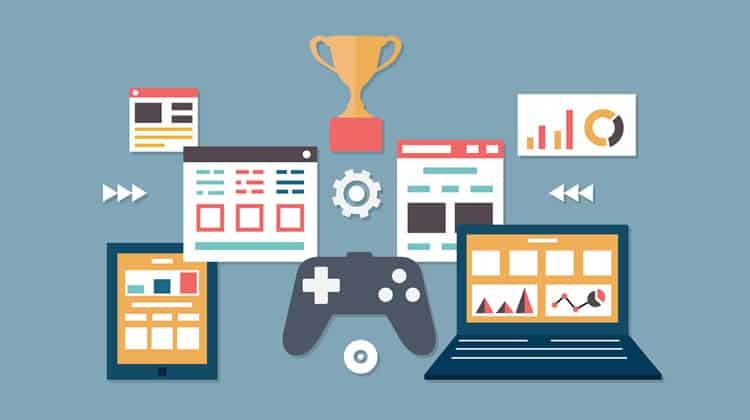Learning has always been about curiosity but somewhere along the way, classrooms started to feel more like routines than discoveries. For students who’ve grown up swiping, tapping, and unlocking achievements on their screens, the traditional model of lectures and tests simply doesn’t click anymore. They expect interactivity, instant feedback, and the thrill of progress the same feelings they get from their favourite games or apps.
That’s where gamified learning ecosystems come in. They take the best parts of gaming points, badges, challenges, levels and blend them into education, transforming lessons into experiences that feel alive. These platforms don’t just ask students to memorise or complete tasks; they invite them to play, explore, and achieve.
The result is a classroom that feels more like an adventure than an obligation. Every quiz becomes a quest. Every assignment feels like a milestone. Every small win builds momentum toward the next level of learning.
For digital-native learners, gamification doesn’t just make learning fun, it makes it meaningful. It taps into motivation, competition, and collaboration in ways traditional education rarely could. And as more schools and EdTech platforms adopt this approach, one thing is becoming clear: when learning feels like play, engagement isn’t forced, it flows naturally.
Why Does Gamification Work in Education?
At its core, gamification works because it speaks the same language students already understand the language of progress, reward, and challenge. It turns the invisible process of learning into something you can see and feel. Every point earned, badge unlocked, or level completed triggers a sense of accomplishment. It’s not just about fun; it’s about feedback, the kind that tells students, “You’re improving.”
Psychologically, this taps into something powerful. The brain releases dopamine when we achieve goals or overcome obstacles. That small burst of satisfaction is what keeps gamers hooked and the same mechanism can be used to keep students engaged with learning. Instead of studying for distant grades, they’re rewarded instantly for effort and growth.
Gamification also plays into two key motivators: intrinsic and extrinsic. Extrinsic rewards like badges or leaderboards draw students in, but intrinsic motivation, curiosity, pride, mastery keeps them there. Over time, learners stop playing for the points and start playing because they love the process of learning itself.
For digital-native students raised in a world of real-time feedback and interactivity, this method feels natural. It turns education from a passive experience into an active, evolving one where every lesson feels like a new level waiting to be conquered.
The Core Mechanics of Gamified Learning Ecosystems
A good game keeps players hooked because it offers a mix of challenge, reward, and progress and the same formula now fuels some of the most effective learning platforms. Gamified education isn’t just about adding flashy animations or digital trophies; it’s about designing systems that motivate students to keep learning, step by step.
Here’s how the key mechanics work together to make that happen:
1. Points: Turning Progress Into Proof
Every completed quiz, project, or exercise earns points tangible proof of effort. These points serve as micro-rewards that track progress in real-time, giving students a reason to push forward even when the material gets tough.
2. Badges: Celebrating Mastery
Badges act like digital certificates, rewarding milestones such as mastering a concept or finishing a unit. They build pride and encourage a sense of accomplishment that traditional grades alone can’t deliver.
3. Leaderboards: Healthy Competition, Shared Growth
Friendly competition brings energy into the classroom. Seeing one’s name climb a leaderboard motivates students to stay consistent, while also fostering a sense of community. When designed thoughtfully, these boards focus on improvement not perfection.
4. Challenges and Quests: Purposeful Play
Learning feels more meaningful when there’s a goal to reach. Challenges like solving real-world problems or completing missions create purpose and excitement. Students aren’t just studying; they’re achieving something.
5. Progress Bars and Levels: Making Growth Visible
Visualising progress is one of gamification’s most powerful tools. A progress bar fills as a student learns, turning abstract improvement into something visible and motivating. Reaching the next level becomes a reward in itself.
6. Interactive Scenarios: Learning Through Simulation
Subjects come alive when students can act instead of just reading. Gamified platforms use simulations like running a virtual business, conducting experiments, or practising a foreign language to make lessons immersive and memorable.
Together, these mechanics build an ecosystem where students don’t just consume information, they interact with it. Every small achievement fuels the next step, creating a steady rhythm of challenge and reward that keeps learning engaging and sustainable.
The Science Behind Motivation and Retention
Gamified learning isn’t a trend; it’s backed by psychology. What makes it effective is how deeply it connects with how our brains are wired to learn, remember, and feel rewarded.
At the centre of it all is dopamine, the brain’s “motivation molecule.” Every time students earn points, complete a challenge, or see a progress bar move forward, dopamine signals a small win. That rush of satisfaction reinforces behaviour in this case, studying and encourages repetition. Over time, the brain starts to associate learning itself with reward, not just the result.
Gamification also creates what psychologists call a “flow state.” This happens when a task is challenging enough to hold attention but not so difficult that it feels impossible. In this state, students lose track of time and focus entirely on the task at hand. By breaking lessons into smaller, manageable levels, gamified systems help learners enter that productive rhythm more easily.
Then there’s feedback immediately and clearly. Traditional education often leaves students waiting days or weeks for results. Gamified systems give feedback instantly, allowing them to correct mistakes, understand concepts faster, and move forward without frustration. That sense of progress builds confidence, which directly improves performance and retention.
Real-world examples back this up. Platforms like Duolingo use streaks, rewards, and short lessons to keep learners consistent. Kahoot! and Classcraft turn classrooms into dynamic, team-based environments. In every case, the outcome is the same: when students enjoy the process, they stick with it longer and they remember more of what they learn.
Gamification, then, isn’t about turning school into a game. It’s about applying what games do best: motivation, mastery, and momentum to make learning more human, engaging, and effective.
From Students to Explorers: Building Real-World Skills Through Play
Gamified learning doesn’t just teach facts it builds the kind of skills that matter long after the test is over. When education feels like exploration, students learn to think, adapt, and collaborate, not just memorise and repeat.
Every challenge or quest in a gamified system mirrors real-life problem-solving. Students are asked to plan strategies, test solutions, and learn from failure the same process professionals use in business, science, and technology. The difference is that, in a game-like setting, failure isn’t final; it’s feedback. That mindset shift makes students more resilient and open to experimentation.
Games also encourage collaboration and communication. Many gamified platforms include group missions or team challenges where students must work together to achieve shared goals. These interactions naturally develop leadership, empathy, and negotiation skills qualities that can’t be measured by a multiple-choice test.
And perhaps most importantly, play fosters curiosity and autonomy. When students take charge of their learning journey choosing quests, tracking their progress, and earning rewards they begin to see learning as something they control, not something done to them. That sense of ownership transforms how they approach education altogether.
In essence, gamified learning turns students into explorers curious, motivated, and confident enough to navigate both virtual challenges and real-world problems with the same energy and determination.
Teachers as Game Designers: The Changing Role of Educators
In a gamified classroom, teachers don’t disappear; they evolve. Their role shifts from delivering information to designing experiences that inspire curiosity and growth. Instead of being the only source of knowledge, they become guides, mentors, and storytellers who shape how students engage with the material.
Think of it like this: in traditional teaching, the lesson is the centrepiece. In gamified learning, the learner is. Teachers use data from AI-powered dashboards to see who’s excelling, who’s struggling, and where the class needs more support. That insight helps them customize lessons, assign targeted challenges, or even design new ones to suit different learning speeds and styles.
Gamification also gives educators more creative freedom. They can craft quests around real-world themes, build friendly competitions to encourage participation, or integrate rewards that celebrate progress not perfection. This makes the classroom feel more dynamic, while giving teachers a fresh way to connect with students who might otherwise tune out.
But what really defines this new role is empathy. Teachers in gamified systems act as co-players, not judges. They guide students through trial and error, encourage collaboration, and remind them that every setback is just another part of the game. The result is a learning environment built on trust and engagement where both teachers and students grow together.
Challenges and Ethical Considerations
Like any innovation, gamified learning isn’t without its pitfalls. While it can make classrooms more exciting and interactive, it also brings challenges that educators and developers need to handle carefully.
The first is over-reliance on rewards. When students are constantly chasing points or badges, the focus can shift from genuine learning to just winning. If not balanced well, gamification risks turning curiosity into competition. The goal should always be to make students want to learn, not just want to score.
Then there’s the issue of competition pressure. Leaderboards can motivate some learners but discourage others. Not every student enjoys being compared, especially if they fall behind early. The healthiest systems promote self-improvement over rivalry, encouraging students to beat their own scores rather than someone else’s.
Accessibility and inclusivity are just as important. For gamified systems to succeed, every learner regardless of background, device, or ability needs equal access. If designed poorly, these tools could widen the very learning gaps they’re meant to close.
And finally, there’s the matter of data privacy. Gamified platforms collect large amounts of student data to track progress and personalise content. Without strong privacy safeguards, this information could be at risk. Ethical design means ensuring transparency, consent, and protection for every learner using the platform.
Gamification has huge potential but it needs thoughtful balance. When used responsibly, it can spark motivation and growth. When used carelessly, it can turn learning into yet another system of pressure and inequality. The key is to keep the human side of learning at the heart of every digital innovation.
The Future of Gamified Learning Ecosystems
The next chapter of gamified learning goes far beyond points and leaderboards. With advancements in AI, VR, and AR, classrooms are on the brink of becoming truly immersive ecosystems where learning doesn’t just feel like play it is play.
Imagine AI tutors that adjust game difficulty in real time, keeping students in that perfect “flow” between challenge and mastery. Or VR classrooms where history lessons turn into time travel, science becomes hands-on exploration, and problem-solving feels like an adventure game rather than a worksheet. These aren’t distant possibilities; they’re already emerging in pilot programs around the world.
Gamified learning will also move toward social and emotional growth. Future systems may use AI to recognise students’ emotional states offering encouragement when motivation dips, or pausing challenges when frustration builds. The aim isn’t just academic success, but emotional intelligence, collaboration, and self-awareness.
Another big shift will come from community-driven learning. Students could form virtual “guilds” or teams across countries, working together to complete global projects and share knowledge. This kind of cross-cultural collaboration turns gamified platforms into ecosystems of shared growth, not isolated competition.
And as these systems evolve, so will the metrics. The future won’t just reward accuracy or speed, it’ll celebrate perseverance, creativity, and curiosity. The best learners will be those who keep exploring, not those who simply finish first.
Education’s future, in many ways, is rediscovering what learning used to be before grades and pressure took over playful, personal, and deeply human.
Conclusion: Learning That Feels Alive
Gamified learning isn’t about turning classrooms into arcades, it’s about turning education into engagement. It’s a reminder that learning doesn’t have to feel like a task; it can feel like progress, discovery, and fun all at once.
By combining the science of motivation with the creativity of play, gamified ecosystems reimagine how students connect with knowledge. Lessons become challenges. Feedback becomes encouragement. And effort becomes achievement.
For teachers, it’s a way to inspire curiosity instead of compliance. For students, it’s an invitation to learn through experience, not just instruction. And for education as a whole, it’s a glimpse into a future where growth feels exciting again.
When learning feels alive, students don’t just study to pass. They play to understand. And maybe that’s the point the more we make education feel like play, the closer we get to making curiosity a lifelong habit.
FAQs:
1. What is the main purpose of gamification in education?
The goal of gamification isn’t just to make learning fun, it’s to make it meaningful. By using game elements like points, badges, and challenges, educators can motivate students, track progress in real time, and build habits that encourage curiosity and consistency.
2. How does gamification impact student engagement and motivation?
Gamification taps into both intrinsic and extrinsic motivators. While rewards and scores spark initial excitement, the real impact comes when students start learning for the joy of progress itself. They stay engaged longer, remember more, and approach lessons with enthusiasm instead of obligation.
3. Is gamification effective across all subjects?
Yes when designed thoughtfully. It works just as well for maths and science as it does for language, art, or history. What changes is how it’s used: quizzes and missions for analytical subjects, storytelling and role-play for creative ones.
4. Can gamification replace traditional teaching?
No. It’s a complement, not a replacement. Gamification enhances what teachers already do by adding interactivity, feedback, and motivation. The best results come when human mentorship and digital systems work together.
5. What’s the future of gamified learning in education?
The next wave will blend gamification with AI, VR, and emotional intelligence creating adaptive systems that respond to each learner’s pace, mood, and goals. The future classroom won’t just teach facts; it’ll inspire lifelong curiosity and collaboration.






